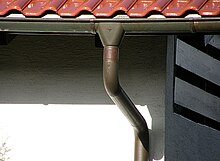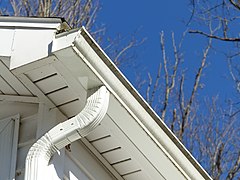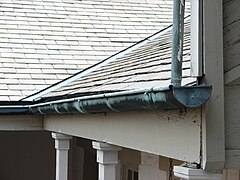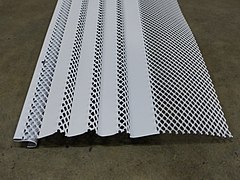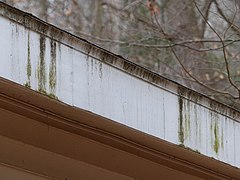Gutter
A gutter (colloquially rain gutter or roof kalle , regional (roof) candelabra or (roof) kännel ; also hangers , (roof) barges (Alemannic), in Switzerland mostly called roof hooks ) is a collecting gutter that drains the roofing off Collects rainwater at the eaves and drains it through a funnel via a downpipe or rain drainage chain . As part of the roof drainage system, it serves to prevent damage to the house as well as injuries or even nuisance to house residents and road users. Where water is missing, difficult to obtain or unaffordable, there is also the function of collecting rainwater with rainwater collectors in cisterns or rain barrels for use.
history
On older roofs made of straw and reed, but also on ancient and medieval houses with tiled roofs , there were generally no rain gutters. While this seldom posed a problem in the more rain-poor southern countries or in rural regions, in the cities that have flourished in Central and Northern Europe since the Middle Ages it did cause problems, as rainwater dripped or fell onto the street in eaves-free houses which was neither beneficial for the people nor for the building fabric. This was one of the reasons why most of the town's houses - with the exception of the corner buildings - were built with gable ends , so that the rainwater fell between the houses, which were often of different heights , into an eaves lane and from there it flowed onto the street.

The earliest gutters were probably made of wood, but it is not very durable. In antiquity and the Middle Ages, they were chiseled out of stone or put together from molded bricks approx. 40 cm long and called Sima in Greek architecture ; the derivation took place mostly via gargoyles . You can find them partly at the Merovingian manor house , then again in the 12th and 13th centuries. In sacred buildings they continued to be made of stone, with the butt joints sealed with cement or grease, which, however, is only partially successful in colder climates. In residential buildings, they were made of wood with internal lead sheet cladding or entirely of lead, sometimes copper. Downpipes made of lead or hollowed stone pillars first appeared in England and France in the 12th century. Metal gutters and pipes did not become common until the 18th century. Cantilever gutters made of metal offer u. a. the advantage of being able to expand or contract slightly without being damaged.
Designs
Gutters are available in different profiles (e.g. semicircular, box-shaped) and for different purposes (e.g. curtain-type gutter, roof gutter, internal gutter, reclining channel, etc.). In addition to the standard channels, any plumbing profiles are feasible.
Materials
Gutters are made of titanium zinc , galvanized sheet steel , copper , stainless steel , aluminum , PVC or wood. The criteria for the selection of the material are the acquisition costs, the durability and the appearance. Galvanized sheet steel and titanium zinc look similar on the outside, but can be easily distinguished with the help of a permanent magnet. Both now look bright and shiny and soon weather to gray. When new, copper is bright red, shiny, but the bright red color becomes darker and darker over time due to the weather - up to dark brown or almost black. The typical green patina that is known from historical buildings only develops over the course of many years or decades. Wooden gutters are still used in traditional rural house construction, in garden design, in areas remote from civilization and recently again in wooden architecture.
Gutters in Germany
Dimensioning
The size of a gutter and the number and diameter of the downpipes depend on the associated roof area and the strength of a local thunderstorm.
Since July 2001, suspended and internal roof drainage systems have to be examined with a hydraulic calculation to ensure that they are adequate.
For economic reasons and to ensure self-cleaning ability, only a medium rain event is used as a basis. According to DIN 1986-100, this is the local five-minute rain discharge - which statistically falls once every five years.
Further influencing factors are the connected roof area (precipitation area projected in the floor plan), the runoff coefficient of roof areas (depending on the roof slope and the time delay between rainwater discharge and actual runoff) as well as influences from the channel length, channel angle, leaf catcher baskets and downpipe distortions, which can lead to a reduction in the drainage capacity ( see DIN 1986-100).
execution
Zinc sheets were previously manufactured using the so-called stack rolling process. The maximum size of the sheet metal was 1 × 2 meters. Due to the poor ductility, folds were preferably made perpendicular to the rolling direction. Therefore, the metal sheets were cut into 2 meter long pieces. The channels were therefore named after the divider of the 2 meter long sheet metal. Although channels are now made of titanium zinc in any length and with bends in the direction of rolling, this name was retained in Germany and adopted for other materials. The pre-material cuts are only based on the end product. The dimensions and further details are regulated in Europe in EN 612. For DIY enthusiasts, the size of the starting material is less of interest than that of the finished gutter. In hardware stores, the diameter of a semicircular gutter (or the width of a box-shaped gutter) is usually given as a guide size (RG), rounded in millimeters:
| Parts / cutting width | New name | Diameter / reference size |
|---|---|---|
| 10 parts 200 mm | 20 channel | 80 mm ring size 75 |
| 8 parts 250 mm | 25 channel | 105 mm RG 100 |
| 7 parts 285 mm | 28 channel | 127 mm RG 125 |
| 6 parts 333 mm | 33 channel | 153 mm RG 150 |
| 5-part 400 mm | 40 channel | 192 mm |
| 4 parts 500 mm | 50 channel | 250 mm |
There are different dimensions for box-shaped gutters or downpipes.
Depending on the material, installation situation and nominal size, compensation for movement must be planned in order to guarantee the temperature- related change in length ( thermal expansion ) without constraint. For example, is in semi-circular box-shaped outer grooves zinc (NW ≤ 500 mm) in accordance with DIN EN 612 every 15 meters a Dilatationsausgleich provided. This can be produced as an overlapped movement joint or with corresponding molded parts.
The gutter is usually fastened with prefabricated gutter brackets (according to DIN EN 1462). These are attached to the eaves plank , rafter or wall. The holders must be sufficiently dimensioned to meet the requirements. DIN EN 1462 / DIN 612 divides the gutter brackets into four stress series and derives the maximum permissible distances from this.
Gutters are laid with and without a slope to the drains. Standing water in the gutters does not lead to any noticeable disadvantage. In the case of the roof gutter, however, a minimum gradient of 5 millimeters per meter is recommended for laying on the roof cladding.
A slope of the gutter transversely to the longitudinal direction is not necessary. However, DIN EN 612 specifies the exact dimensions for an elevation (8–20 mm) of the rear edge of the gutter in order to prevent water from penetrating the roof structure in the event of a backwater.
Norms
- DIN EN 12056-3 Gravity drainage systems within buildings, Part 3 - Roof drainage, planning and dimensioning
- DIN 1986-100 Drainage Systems for Buildings and Land, Part 100 - Additional provisions to DIN EN 752 and DIN EN 12056
- DIN EN 612 hanging gutters and rainwater downpipes made of sheet metal; Terms, classification and requirements
- DIN EN 1462 gutter bracket for hanging gutters; Requirements and testing
- "Guidelines for the execution of metal roofs - external wall cladding and building plumbing - technical rules of the plumbing trade" from the Central Association of Sanitary, Heating, Air Conditioning.
Gutters in other countries
United States
In the United States , most roofs are covered with asphalt shingles ( Roof Shingles , Asphalt Shingles ) rather than clay tiles. Nevertheless, fundamentally similar materials and shapes are used for gutters ( gutters , rain gutters ) as in Germany.
Box-shaped gutters (“K-Style Gutters”) made of PVC, aluminum and steel are most widespread today. PVC ( vinyl ) products are cheaper but less durable than metal ones. The price and durability of metal products depends primarily on the thickness of the material. Steel is more robust than aluminum, but prone to rust.
The K-style gutter have to receive over half-round gutters One of the advantages with the appropriate diameter more water. They are designed like crown molding and therefore fit in well with houses that are built in antique styles; In the USA, historic building is still the rule today. Because they are flat on the side facing the roof, they can be attached more or less directly to the roof edge ( fascia ). On shingle-covered roofs, in order to protect the roof edge from moisture, a Gutter Flashing (also: Drip Edge ) made of aluminum or plastic is installed between the shingles and the underlying roof sealing ( Ice & Water Shield ) , the rainwater from the roof directly into the Gutter directs.
For tiled and slate roofs as well as for houses with rounded shapes, semicircular gutters are often preferred for visual reasons. They are easier to clean than K-Style Gutters , and because water is less likely to collect in them, they are slightly less prone to corrosion. Due to their relatively high price, among other things, semicircular gutters are much less common in the USA than K-style gutters . They cannot be mounted directly on the eaves, but require special brackets.
Gutters made of aluminum and steel - regardless of whether they are K-style or semicircular - are often formed as seamless gutters on site by craftsmen using a special machine ( portable gutter-making machine ) from rolled sheet metal and cut to size as required. One advantage of this process is that there are no seams other than at the ends that could leak. Pre-cut gutters are also customary in DIY stores.
Especially for buildings in modern styles - this only affects a minority of residential buildings in the USA - gutters are also occasionally offered, which are referred to as contemporary or modern . Box and other angular shapes predominate here. Unadorned box-shaped gutters and downpipes are also the norm on commercial buildings.
PVC gutters are almost exclusively produced in white or brown. Products made of aluminum and steel are enamelled and can basically be produced in different colors, but the predominant colors are white and brown. Unlike PVC gutters, however, they can be painted as required.
In order to counteract contamination and clogging - for example through leaves or snow - rain gutters are now often covered with various types of grids or other elements ( gutter guards ).
Individual evidence
- ↑ Handbook of Architecture , Part II, Vol. 1 Architecture of the Greeks (Josef Durm), p. 96 u. 106, Vol. II Architecture of the Romans (Josef Durm), p. 203 ff.
- ^ Eugène Viollet-le-Duc : Dictionnaire raisonné de l'architecture de France , 1854–1868, Vol. 3, pp. 217–226
- ↑ a b Selecting Rain Gutters for your Roof. Retrieved March 5, 2020 .
- ↑ a b Vinyl vs Aluminum Rain Gutters. Retrieved March 6, 2020 .
- ↑ a b Aluminum vs. Steel: Which Gutter System Is Best For You? Retrieved March 6, 2020 .
- ↑ K-Style Gutters. Retrieved March 5, 2020 .
- ↑ a b When You Should Be Using Half-Round Gutters vs. K-Style for Your Home. Retrieved March 6, 2020 .
- ↑ What Is Gutter Flashing? Retrieved March 6, 2020 .
- ↑ a b c K-Style Gutters vs Half-Round Gutters. Retrieved March 6, 2020 .
- ↑ Roll Forming Seamless Gutters. Retrieved March 5, 2020 .
- ↑ Contemporary Gutters. Retrieved March 6, 2020 .
- ↑ Rain Gutters - What You Should Know Before You Buy. Retrieved March 6, 2020 .
- ↑ 5 Benefits of Gutter Guards. Retrieved March 5, 2020 .
- ^ The Best Gutter Guards for Your Home. Retrieved March 5, 2020 .
